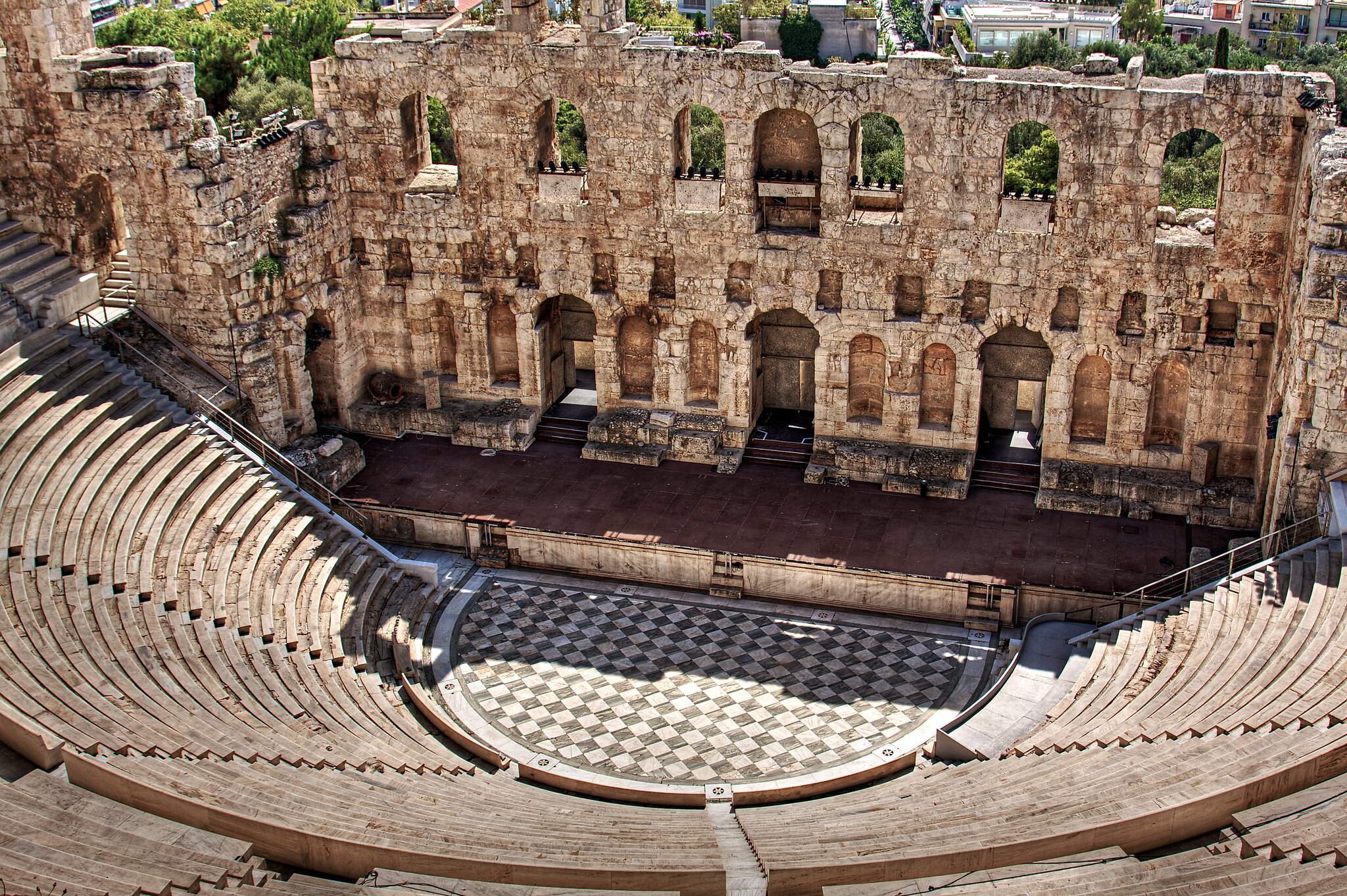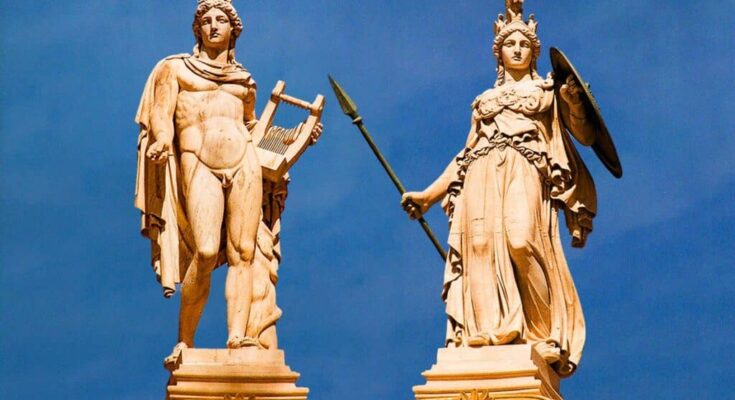
Ancient Greece built brands that rival any modern corporation. From grand statues to copy-like histories that still capture audiences, ancient Greeks knew how to sell.
In essence, it was all about control—control of how they were seen, who they were remembered as, and how far their influence stretched. Greek elites achieved this by harnessing visual, verbal, and experiential mediums to cultivate their brand.
Visual branding
Before presidential addresses and social media, most ancient peoples got to know their rulers through propaganda. Towering temples, imposing statues, and scintillatingly struck coins were the most direct link between a sovereign and the people.
Without modern communication, visual mediums embedded the ruler’s likeness into everyday life. Far more than mere spectacles, they were statements of power, wealth, and control. A leader’s reputation was not just told—it was shown. The more grand and permanent the monument, the more lasting the influence.
Temples

The Parthenon is perhaps one of the best examples of cultural branding. Built on the Athenian Acropolis under the supervision of Pericles, this massive temple inspires worship at first glance. However, its function did not end there. It was a declaration of Athens’ power.
Pericles initiated the building project, understanding the political potential of architecture. The Parthenon symbolized the city’s intellectual dominance and military strength over the Persians. The construction of the Parthenon was, in part, a response to this devastation—a bold statement that Athens had not only survived but had risen stronger than ever after the Greco-Persian wards (480 BC).
The Parthenon’s frieze and metopes significantly reinforced this message. The frieze depicts mythological allegories to celebrate Athens’ victory over Persia. The Amazonomachy, which represents the Greeks’ mythic struggle against the Amazons, and the Gigantomachy, the battle between the gods and the giants, were both prominently featured.
These mythical conflicts symbolized the real-world struggle between the Greeks and the Persians. The mythical depictions on the Parthenon allowed Athens, under its grand leader, Pericles, to place itself at the center of a grand cosmic struggle between order and chaos, civilization, and savagery.
The Parthenon rose above the city, reminding everyone who looked up at it who was in charge. It wasn’t just religious but a symbol of imperial Athens at the height of its power. Pericles knew that by investing in such a structure, he was also investing in his political branding.
Statues

Like monumental structures, statues were fundamental in a leader’s image. A prime example of this is Mithradates VI Eupator, the king of Pontus, who actively used statues and sculptures to reinforce his divine lineage.
Mithradates, one of Rome’s deadliest enemies, sought to present himself as a powerful monarch with divine connections. He commissioned statues that linked him directly to Hercules and Dionysus, two gods whose qualities he wished to embody in both his military and cultural persona.
In many of these works, he is depicted wearing the lion skin of Hercules, signaling his divine heritage. In others, his features echo Dionysus’s likeness, including the god’s curly hair and carefree demeanor.
Mithradates ensured that statues were placed strategically in temples, public spaces, and essential sanctuaries throughout his kingdom and his allies. In a time of shifting alliances, the Mithradates brand played a significant role in uniting much of the Greek-speaking world against Rome.
Through this visual propaganda, Mithradates cemented his identity as a Hellenic leader, leading the struggle against the new barbarian threat from the West. However, he wasn’t the first. Mithradates was taking pages from his predecessor’s handbook.
Coins

Mithradates’ alleged forebear, Alexander the Great, made visual branding into an art form. Nothing illustrates his ability more than the Macedonian king’s use of coins. Coins carried leaders’ faces across regions, spreading their influence wherever trade traveled.
Alexander the Great used his image on coins to portray himself as a near-divine figure. He issued coins wearing Hercules’ lion skin, reinforcing his divine descendance. The currency became a mobile billboard, a way for Alexander to brand his power and extend his influence to the edges of his empire. This wasn’t accidental.
Like his Persian predecessors, he needed to unify his vast territories and cement his image as a legitimate successor to the Persian kings—so much so that he had approximately 3,120 tons of precious metals looted Persian gold melted down and turned into coins that could be circulated throughout his empire.
These coins were symbols of his triumph and tools of influence. They circulated far and wide, reaching from Greece and Macedonia in the west to Egypt in the south and as far east as India. In fact, Alexander’s coins remained in circulation long after his death and were used by the Hellenistic kingdom’s successor states.
These coins contributed to Alexander’s mythologization, symbolizing power and legitimacy. Minting Alexander’s face on coins allowed his successors to legitimize their rule. Alexander the Great’s coins carried a visual legacy, one that echoes into the present day.
Verbal branding
Unlike visual propaganda, which is limited in what message it projects, words have the power to capture more of an angle or story that a leader wants to be remembered as.
Recorded histories, rhetoric, and drama were tools that shaped perceptions, swayed crowds, and built the brand of leaders and city-states. Skilled speakers and eloquent writers could turn public opinion with words more than deeds. After all, did the tree fall in a forest if no one witnessed it?
Professional rhetoricians and sophists

In a world without newspapers, leaders employed professional rhetoricians—sophists—to craft arguments and boost their reputation.These skilled speakers were paid to win debates and to use logic and emotion to shift public opinion.
In the Athenian Assembly, the right speech could mean the difference between war and peace, exile or glory. Gorgias, a famous sophist, was known for turning any argument in his favor, making him a valuable asset to those looking to sway the masses.
Gorgias was sent as an ambassador from Leontini to Athens in 427 BC to secure Athenian military support for Leontini in its conflict with Syracuse. Although none of his speeches survive, Plato and Aristotle both describe Gorgias’ rhetorical technique as dazzling his audience with clever language.
What we do know is that Gorgias was successful in garnering support for securing Athenian support for Leontini in its struggle against Syracuse. In the context of brand building, Gorgias likely helped elevate Leontini’s image as a city worthy of Athenian aid and partnership.
His rhetorical skills would have been employed to position Leontini as a prominent player in Sicilian politics and a valuable ally for Athens in its efforts to expand its influence in the Western Greek world. Orators weren’t just limited to building up a person. Demosthenes, an Athenian statesman, and orator, crafted speeches against Philip II of Macedon in what is now known as the Philippians.
His speeches were a rallying cry aimed at uniting the Greek city-states against the rising power of Macedonia. Demosthenes famously characterized Phillip as a barbarian. Although ultimately unsuccessful in preventing Macedonian dominance, his words influenced Athenian revolts against the Macedonians.
Hired historians

Like Alexander’s retractors from Athens, the Macedonian king himself was busy building his image. Alexander the Great understood the importance of controlling the story of his conquests, so he brought along several historians on his campaigns to record his achievements.
Controlling the narrative was crucial, and leaders like Alexander the Great knew this well. Rather than relying on later historians to piece together the pieces of his campaign, Alexander wanted to have full creative rights to his story.
He brought along historians on his campaigns to ensure his conquests were recorded favorably. These hired historians blended fact with glorification to cement his legacy. Among them was Callisthenes of Olynthus, a relative of Aristotle, who documented Alexander’s early campaigns. His accounts portrayed Alexander as a heroic figure destined for greatness, emphasizing his divine favor and military genius.
Anaximenes of Lampsacus and Aristobulus of Cassandreia also recorded his deeds, ensuring his image spread across the empire. These historians played a key role in shaping Alexander’s reputation, casting his conquests as part of a grand, divine mission.
Though some, like Callisthenes, fell out of favor (and even met tragic ends), their writings contributed significantly to Alexander’s enduring image as a near-mythic figure and legitimate ruler of both Greece and Persia.
Storytelling and narrative

Like historical narratives, narratives on stage were used to sway the masses through entertainment. Plays often addressed contemporary political issues, social values, and civic responsibilities, providing leaders with an opportunity to influence the narrative.
One of the most notable examples of this is Pericles, the Athenian statesman, who understood the potential of drama as a form of cultural and political propaganda. As a patron of the arts, Pericles actively sponsored playwrights and productions, using them to project Athens as a city of intellectual and cultural supremacy.
His support of plays during the Dionysia, the city’s major theatrical festival, allowed him to align his leadership with Athens’ flourishing arts and values. Pericles’ association with Aeschylus, one of Athens’ greatest tragedians, is particularly significant. Aeschylus’ play The Persians (472 BC) was produced during Pericles’ rise to power.
This play, which depicted the Greek victory over Persia at the Battle of Salamis, served as a reminder of Athens’ military and cultural dominance. By sponsoring these types of works, Pericles reinforced his own image as a defender of Athens and as a leader aligned with the city’s most significant victories.
Through his patronage of drama, Pericles positioned himself as both a protector of Athens and a key figure in its cultural life. The sponsorship of plays allowed him to control the narrative, ensuring that the stories reaching the masses supported Athenian superiority and civic pride.
In this way, drama became a tool for verbal branding, shaping how both Athens and its leaders were remembered.
Experiential branding:
While seeing and hearing is believing, experiencing is knowing. Ancient Greek elites took branding to another level with events that incorporated multi-sensory experiences that made their power feel tangible.
These experiences were grand, immersive, and profoundly influential.
Public festivals

Public festivals and games were among the most effective forms of experiential propaganda. The Panathenaic Games in Athens, for example, were not only a religious celebration in honor of Athena but also a political stage used by the Athenian elites to demonstrate their wealth, piety, and leadership.
Leaders like Pericles took advantage of the festival’s grandeur, blending athletic contests, processions, sacrifices, and musical performances to emphasize Athens’ dominance and culture.
The grand procession through the city to the Acropolis, where offerings were made to Athena, was one of the most important spectacles, and it showcased the unity and strength of the city under its leaders.
Through sponsorship and organization of these events, Athenian elites positioned themselves as key patrons of the city’s culture and religion.
These events were deeply political. By associating themselves with the success of the games, leaders could project an image of themselves as protectors of Athenian values and contributors to its glory.
The victories in the games, which were dedicated to Athena, reinforced the connection between the gods’ favor and the city’s leadership. For victorious athletes, their personal success became a source of civic pride. Leaders would often reward these athletes publicly, and statues or monuments were erected in their honor, further connecting the victory to the prestige of Athens itself.
In this way, the Panathenaic Games functioned as both a religious and political event, allowing Athenian elites to stage a grand spectacle that magnified their influence and reinforced the cultural and political superiority of the city.
Weddings

Weddings were another form of experiential propaganda. In the Hellenistic period, weddings became grand, multi-sensory spectacles designed to showcase the ruler’s wealth, divine favor, and ability to unite vast and diverse peoples under one banner.
One of the most famous examples of a wedding used for political branding was Alexander the Great’s mass wedding at Susa in 324 BC. After years of conquering the Persian Empire, Alexander sought to unify the Macedonian and Persian elites through a highly symbolic and staged event.
In a single ceremony, Alexander married Stateira, the daughter of the defeated Persian king Darius III, while also arranging the marriages of 80 of his officers to Persian noblewomen.
The spectacle was designed to symbolize the merging of the Greek and Persian worlds, reinforcing Alexander’s vision of a unified empire. By marrying into the Persian royal family, Alexander projected himself as the legitimate ruler of both the Greek and Persian realms.
The event itself was a lavish, multi-sensory affair. Alexander and his officers were dressed in Persian robes, and the celebrations included grand feasts, music, and rituals. The public spectacle emphasized his power and divine favor, with the marriages intended to cement loyalty among the newly conquered Persian elite.
The mass wedding served as both a political act and a cultural performance, showcasing Alexander’s ability to unite different cultures under his rule. This lavish matrimony was a calculated display of experiential branding. It presented Alexander as a unifier and leader of a global empire, symbolically marrying the East and West.
Spectacle diplomacy

Diplomatic rituals were another powerful way to build a brand. The way a ruler treated foreign ambassadors could signal wealth, power, and generosity. Take Mithradates Eupator, who hosted an Athenian ambassador, Athenion.
The Pontian king clothed the man in purple and gave him a gold ring, making sure the entire court witnessed the event. The Athenian ambassador didn’t just return home with gifts. He returned with a story of Mithradates’ greatness, one that would circulate in Athens and beyond. Hospitality was diplomacy, but it was also a way to advertise the host’s power.
Xenia, or guest-friendship, was central to Greek diplomacy. When a leader extended lavish hospitality to foreign envoys, it was a public spectacle of wealth and influence. This experience shaped the perceptions of both the host and the guest.
As Duggan observed, “with absurd and sublime devotion,” Athens declared war on Rome after generations of military inactivity. Mithradates had secured Athens, and gradually, most of Greece and the surrounding regions came under his influence through his brand.
The lasting power of ancient propaganda
Brand building in ancient Greece was nothing short of a successful “content strategy.” Leaders deployed a well-rounded mix of visual, verbal, and experiential tools to craft their image and extend their influence.
By looking at how the Greeks projected their image, we appreciate the timeless art of brand building still employed today. The same strategies are used by influential companies that shape how we interact with the present world.



